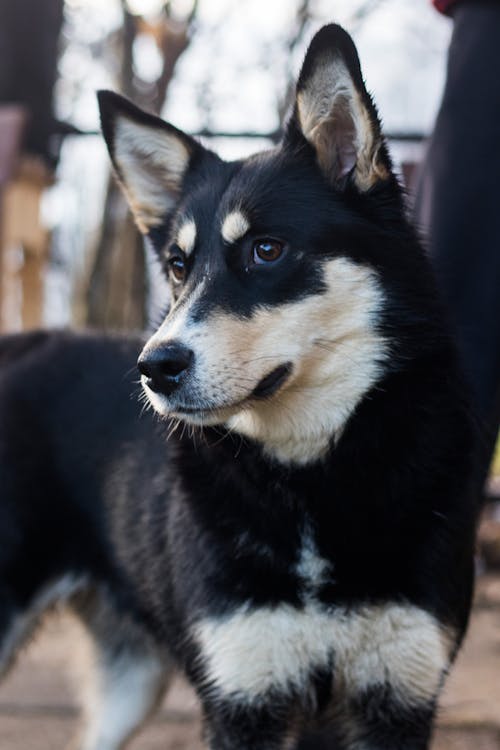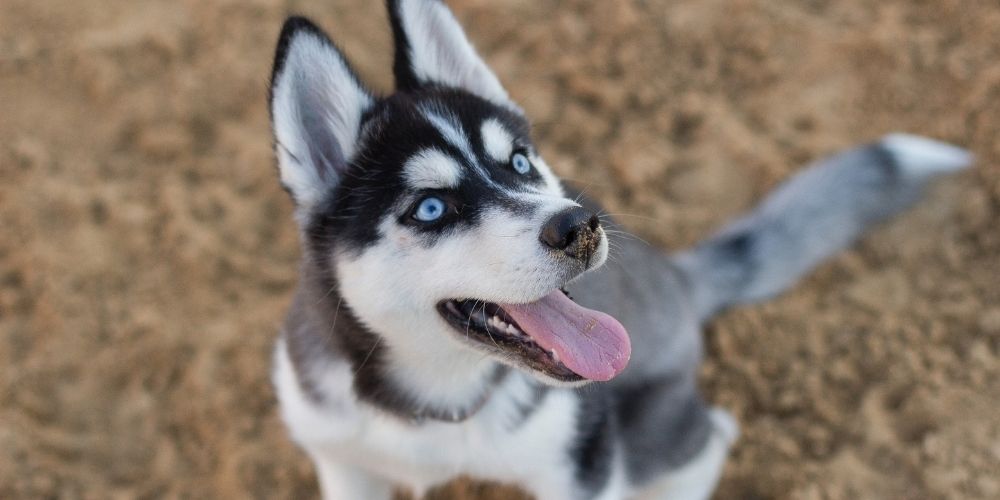Know everything about your favorite dog breed
In this article, We’ll talk about why do huskies have different colored eyes? Huskies are well known for their distinctive colored eyes. Their almond-shaped eyes are typically colored blue or brown. Sometimes, each eye has a different color. Such Huskies appear even more majestic. Different colored eyes are more commonly seen in Huskies than you think.
Why Do Huskies Have Different Colored Eyes-A Detailed Guide
Bi-eyed Huskies have eyes of two different colors. Typically, one eye is blue and the other is brown. Bi-eyed Huskies are relatively rare because of only about fifteen percent of dogs of this breed exhibit this phenomenon. Unlink popular beliefs, big-eyed Huskies have no disparity in vision and just as healthy eyes as other Huskies.
The different colored eyes occur because of a genetic mutation
Some Huskies have a genetic mutation that imparts a different color to each of their eyes. This phenomenon is also known as heterochromia. Huskies with heterochromia generally have one blue and one brown eye.
Heterochromia is a genetic condition
Only about fifteen percent of all Huskies have this genetic condition. However distinct such Huskies may appear, this eye coloration is totally normal and has no impact on their health. Most Huskies have two eyes of the same color.
The color of the eyes is determined by the distribution of melanin
The color of the eyes depends on the melanin concentration. Melanin is a natural pigment that imparts color to the skin, eyes, and hair. The pattern of distribution and the concentration of melanin determines the specific eye color of Huskies. Huskies with heterochromia have different concentrations and distribution of melanin in both eyes. However, this does not impact their health.
The iris of dog eyes has melanocytes that impart the common brown color to the eyes. The strength of the melanin and its distribution are affected by this genetic mutation. It is the lack of melanocytes that brings about different eye colors in Huskies.
Bi-eyed Huskies have normal eyesight
Bi-eyed Huskies are just as normal as other Huskies. The heterochromatic condition does not affect their health or temperament in any way. Bi-eyed Huskies have normal eyesight and are not more susceptible to eye problems than other Huskies.
Bi-eyed Huskies are not mixed breeds
Heterochromia is a genetic phenomenon and is normal in Huskies. Bi-eyed Huskies are not mixed breeds. This phenomenon is not only seen in Huskies but also in certain other dog breeds. Even some human beings have this condition.
Some Huskies have particolored eyes
An even rare condition in Huskies is when their eyes are particolored. This is when each eye has a mixture of two different colors in them. This phenomenon is rare and occurs in about five percent of Huskies. The blue and brown colors are blended together in particolored eyes.
Parti-colored eyes are completely normal
Parti-colored eyes are totally normal. No matter how otherworldly they appear, they are not more prone to health problems. The extraordinary particolored eyes in Huskies is also a genetic condition and does not accompany any proneness to eye diseases.
Different colored eyes are more common in Huskies than other dogs
Heterochromia is a more common phenomenon in Huskies than in the dogs of other breeds. Different colored eyes are also seen in dogs like Australian Shepherds and Border Collies but it is not as common as in Huskies.
Heterochromia is not bad for Huskies
Huskies may be generally prone to eye problems, but heterochromia does not make them more prone to develop eye disorders. It does not affect their ability to see in any way. However, you must pay attention to any abnormal change in the color of your Husky’s eyes.
Cloudy eyes or extremely light blue eyes could be a sign of a cataract. It is best to get such a change in color examined by a veterinarian as soon as possible.

About forty percent of Huskies have blue eyes
Blue eyes are relatively common in Huskies. About forty percent of Huskies have blue eyes. These striking blue eyes are a characteristic of Huskies. The blue is present in various distinguished shades like deep blue and ice blue.
Blue-eyed Huskies also have special characteristics for the required protection of their eyes. There is a ring of dark skin around their eyes that protects them against reflection and glare. This dark skin helps in deflecting direct sunlight and saves the eyes of Huskies from the effect of harmful UV rays.
Brown is another common eye color in Huskies
Forty percent of the Huskies have blue eyes and another forty percent have brown eyes. The brown coloration exists in various shades ranging from light brown to dark chocolate brown. Contrary to false popular notions, brown eyes are also very common in Huskies and brown-eyed Huskies are also pure-bred.
The eye color of Huskies changes with age
It is a known fact that all Huskies have blue eyes at birth. This color changes with age. The permanent color of their eyes appears around the age of twelve to sixteen weeks. The variations in color start occurring when they are around five to eight weeks old.
The eye color depends on the distribution of melanin
The color of Husky eyes changes with age and it is dependent on the distribution of melanin. The distribution and concentration of melanin influence the appearance of color in the skin, hair, and eyes of Huskies.
Not all Husky eyes remain blue
All Huskies have blue eyes at birth but many of them change to different colors as they grow up. Some change to different shades of brown, others changes to parti-colored or bi-colored variations.
Sometimes the eye color of Huskies keeps changing until six months of age
The color of Husky eyes usually stops changing around the age of twelve to sixteen weeks. But it has often been seen to change as late as six months. It is not common for the color of the eyes to change so later in age. It is best to get them checked by a veterinarian so that any eye problems can be ruled out.
Unlike other dogs, blue eyes are not bad for Huskies
All Husky puppies are born with blue eyes. It is a dominant trait in Huskies and the color of their eyes changes to its permanent shade until five to eight weeks of age. Most other breeds of dogs report eye problems associated with blue eyes. However, this is not the case with Huskies.
Blue eyes in Huskies occur because of a genetic mutation
All Huskies have blue eyes at birth because of a genetic mutation near a specific gene. The location of this mutation results in a decreased production of melanin pigment in the eyes and makes them look blue.
Blue eyes in other dog breeds are generally a sign of eye disease
For many other breeds of dogs, the occurrence of blue eyes is the sign of underlying eye disease. In such a case, the dog should be thoroughly examined by the veterinarian and the particular condition be treated.
Blue eyes are normal in certain other dog breeds too
While blue eyes are particularly common in Huskies, they are not the only dogs with this dominant trait. Certain other breeds of dogs are also known to have normal blue eyes. This includes Australian Shepherds, Dalmatians, Border Collies, Dachshunds, Cardigan Welsh Corgis, and Weimaraners.
Blue eyes Huskies are not more susceptible to blindness
Unlike popular notions, there is no scientific evidence to prove that blue-eyed Huskies are more susceptible to blindness. Although, you must pay attention to any abnormal change in the color of your Husky’s eyes. An extremely light blue color or cloudiness could be a sign of corneal dystrophy or cataract.
Blue eyes are not more prone to damage by sunlight
Blue eyes are not susceptible to damage by sunlight. In fact, cataracts occur because of certain recessive genes rather than mere exposure to sunlight. Just because blue eyes lack melanin pigment, they are not more prone to eye disorders.
Huskies are generally more prone to eye conditions
As compared to other breeds of dogs, Huskies are generally more prone to eye conditions. Huskies commonly have hereditary eye conditions and it is not known whether heterochromia has a role.
The three main eye disorders in Huskies are corneal dystrophy, juvenile cataracts, and progressive retinal atrophy.
Conclusion
About fifteen percent of Huskies are bi-eyed and about five percent of Huskies have particolored eyes. The difference in the coloration of Husky eyes is a phenomenon called heterochromia which occurs because of a genetic mutation.
There is no scientific evidence to prove that heterochromia is related to the occurrence of various eye disorders in Huskies. Huskies with heterochromia have normal eyesight.
Blue eyes are known to be associated with eye problems in most other dog breeds but not in Huskies. In fact, all Huskies have blue eyes at birth. The color gradually changes to their permanent eye color until five to eight weeks of age. But any abnormal changes in the color of eyes to unsightly blue or the appearance of cloudiness should be checked by a veterinarian.

